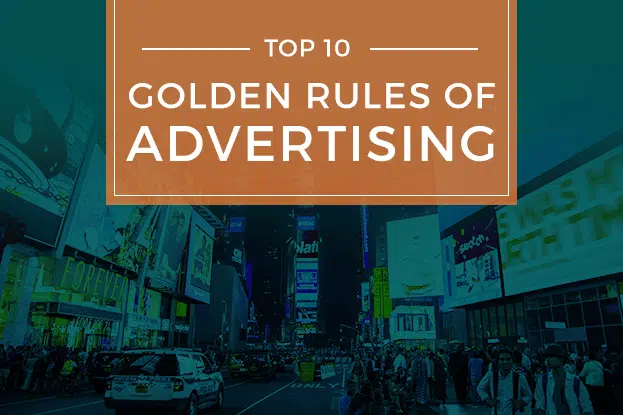

It’s not unusual for some clients to ask for an amazing advertising campaign that needs to transform their business—by tomorrow. To avoid this situation, we’ve created a guide to outline the rules of advertising.
If you do find yourself in this situation, we want to give you some advice. Instead of shouting and crying, you want to set expectations so that there’s as little confusion as possible. You may still have clients who misunderstand advertising, and there will always be those clients.
So, to set expectations, here’s our list of 10 must-know rules for advertising.
#1 – Advertising will make a bad product fail faster.
This is a fact, so repeat it until you lose your voice. It doesn’t matter how good your intentions are when you created or released your product—if you’re spending a lot of money promoting it and no one is buying it, then it might be best to go back to the drawing board.
It’s always possible that you overlooked other essential parts of the marketing mix, like place or price. But unless you have absolutely zero exposure, your product isn’t selling because no one wants it.
How do I avoid this?
Do market research. Sure, you might have a decent product, but you need to know for sure that there are people who actually want to buy it. The more unbiased research you conduct, the more you’ll understand about improving your product or tactics.
#2 – Advertising takes time.
To start, advertising takes more than a few days to be created. The most creative and original campaigns in the world take months to create, and even smaller ones take weeks. Creativity can’t be rushed—for cheap, anyway.
Second point: It takes time for your ads to begin working. It might take six or seven impressions before you remember the brand from an ad. It might take 10 to 15 impressions before someone is ready to buy—even when they’re part of the target audience. Overall, advertising takes weeks before you start noticing a difference.
How do I avoid this?
Plan ahead. If you know that your audience will begin purchasing in the fall, prepare during the spring before. If you know what winter months are less profitable, plan a more creative campaign, instead of simply offering discounts. This all starts with a marketing and communications plan, which is an essential part of running a business.
Alternatively, promote an offer that needs to be redeemed quickly. A flash sale, 24-hour promo, or weekend deal is a great way to create urgency among your audience. Still, you should plan these promotions weeks, or even months, in advance.
#3 – Expect failure.
Simply put, most ads either don’t persuade, aren’t placed in the right context, or aim to be unremarkable. (Although, instead of unremarkable, clients call them “professional” or “polished”.)
Try something new, and place that fresh idea or message in front of your audience. Don’t be afraid to be creative—assuming it’s relevant, your audience will respect you for it.
Ask why someone will care if you’re offering 20% off, or a second item free, or you’re releasing a new product. Ask if you’re providing any degree of entertainment. The best ads inform through entertainment and persuasion.
How do I avoid this?
Test your ads. Do research, put out a few different ads, and analyze your findings. If you do this properly, you’ll always discover something helpful.
Remember this: It’s affordable to fail online. Test out a few AdWords or Facebook ads and learn as much as possible before going big. Fail, then learn, then improve and succeed—because really, that’s the entrepreneurial spirit in a nutshell.
#4 – Think of your audience first.
One of the worst mistakes a business owner can make is to forget about his or her audience. Sure, you want your website, Facebook ad, or logo to look good, but what you think is good might be something your audience hates.
This is a deal-breaker for anyone who doesn’t have an amazing product that sells itself (which, by the way, is pretty rare). A 20-year-old is less likely to fall in love with a brand that looks like it’s aimed at his or her parents.
How can I avoid this?
Research. Maybe you’re noticing a trend here, but research is everything in this industry. Nothing happens by accident, and nothing is a coincidence. So ask members of your audience, test out some imagery or messaging, and see how people react.
#5 – Advertising budgets don’t scale evenly.
In marketing, $5 gets you zero Facebook Likes, and $10 gets you 3 Likes, and $20 gets you 10 Likes. The more you invest, the more you’ll get back in every space.
If you’re on a very tight budget, it’s best to do the work yourself. Do research, learn to use Photoshop, make sure your writing is effective, and ask for help when it’s available. Agencies aren’t cheap, and it’s better to not hire anyone than to hire a weak writer or designer to do your work.
How can I maximize results?
Spend time learning the tools. The Internet has made everything in marketing accessible to business owners. Your $200 monthly budget is too small for most agencies, but it’s a lot if you’re setting up your own ads.
#6 – Not all data can be tracked.
Truth be told, only about half of marketing is driven by data. The rest is an unbalanced mix of optimism, instinct, and experience. Talent and luck also apply to some level. But only about half is analytics, research, and tracking.
You can learn from data, but the real trick is understanding that not all data is completely trustworthy, and that interpreting data is the tricky part.
How can I maximize results?
Once again, research. It’s best to really spend time with your data, and come up with theories as to why certain actions are taking place. For example, if most of your website visitors are new visitors, and you recently set up a Facebook Page, there’s probably a connection there.
#7 – The right answer today is the wrong answer tomorrow.
Something might work flawlessly at one time, and then not at all later on. Times change, trends shift, and people come and go. A brilliant idea will totally fail someone, and skyrocket someone else to the top.
That’s why companies rebrand, change their logos, change their taglines, and, sometimes, go out of business. The challenge is keeping up, and your messaging can help you do that.
How can I avoid this?
Keep up with trends in your industry—and everywhere else. Learn the difference between a flash-in-the-pan fad, and a durable trend.
You shouldn’t copy your competition, but you shouldn’t be afraid to take advantage of certain resources. For example, if your industry is now selling most products online instead of at a store, then it might be a good idea to set up an e-commerce website.
#8 – Be relevant.
So obviously, you shouldn’t create ads that depict bikini-clad models if you’re promoting a daycare. Sure, that’s a given. But what about using emojis for a local bank? Or Tom Cruise to promote greek yogurt? What about a clown mascot for an airline?
Keep your audience in mind, too. Do 20-year-olds care about Tom Cruise? Is it appropriate to advertise to 50-year-olds using Marvel superheroes? Do new moms like vulgarity? Think it through before it costs you money.
How can I maximize results?
Be critical—but optimistic—of your creative content. There are usually grey areas with relevancy in advertising, but it’s best to ask yourself, “how does this connect to my product or brand?” along with, “do I want my target audience associating this with my product or brand?”
#9 – Be optimistic.
Think for a minute about an ad that you like. Now, imagine what the pitch probably sounded like. Imagine having an idea for something that only you can envision, and having to stand in front of a group of people, and try to explain that idea.
A bad idea will probably be disliked. A good idea, somewhat liked. A great idea, probably ridiculed or hated in the initial meeting, especially if the presenter doesn’t do it justice. So stay optimistic, and aim to be pleasantly surprised.
How can I maximize results?
Listen to a pitch the whole way through. Ask questions, and try to imagine the concept from the audience’s perspective. This will give you a fair idea if it’s worth proceeding with that idea.
#10 – Don’t use clickbait. Ever.
If it draws attention away from the message, logo, brand, or main idea, it’s clickbait. It’s not just web articles that use clickbait—anything that’s irrelevant or empty content, but with an attractive hook, can be clickbait.
One of the oldest types of clickbait was, well, outright lying. Snakeoil and miracle cures came first. Then, using attractive women that had nothing to do with the product. Then, it was misleading headlines that were followed by fine print. Anything to grab attention, only to lose it shortly afterward because of some flaw, is a dishonest and ineffective way to build a business.
If you like repeat customers, brand credibility, fair profits, and (in rare cases!) staying out of prison, then clickbait is out of the question.
How can I avoid this?
Create quality content. Be honest, be clear, and treat potential customers the way you want to be treated. Clickbait is also expensive and is being cracked down upon, so just don’t do it for humanity’s sake.
What are your golden rules of advertising and marketing? Let us know by leaving a comment!

Recent Articles
Write For Us
Think you’ve got a fresh perspective that will challenge our readers to become better marketers? We’re always looking for authors who can deliver quality articles and blog posts. Hundreds of your peers will read your work, and you will level up in the process.Ready to grow? Say Hello






